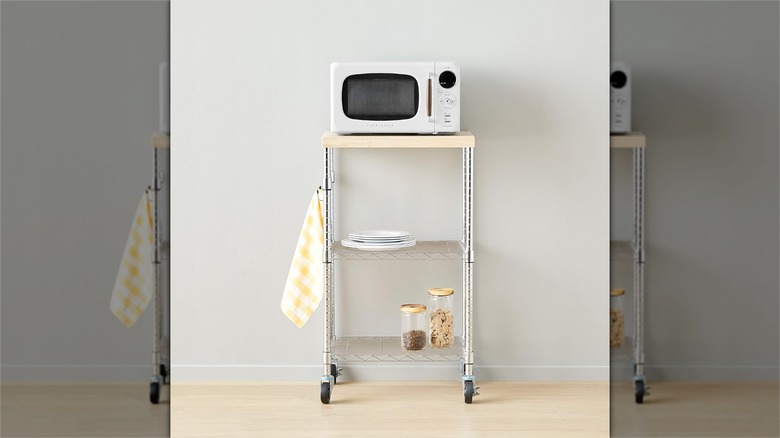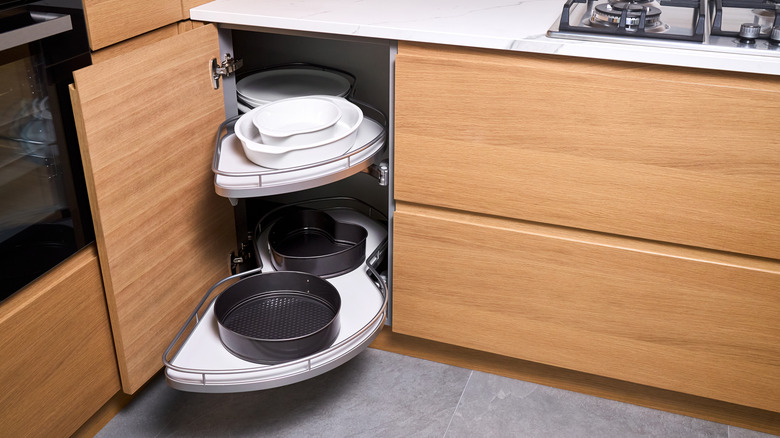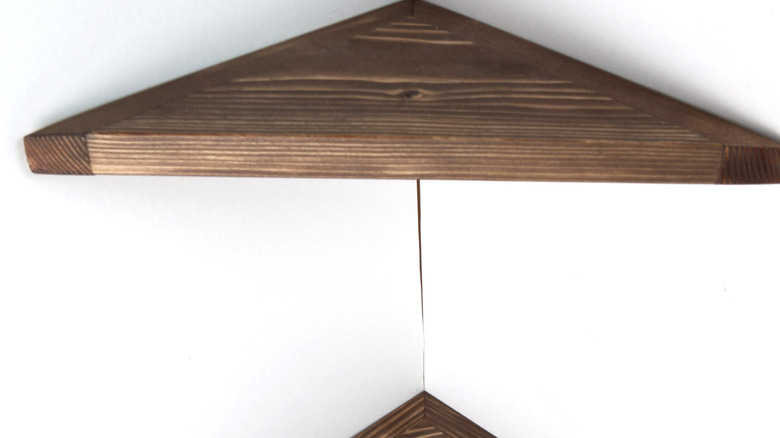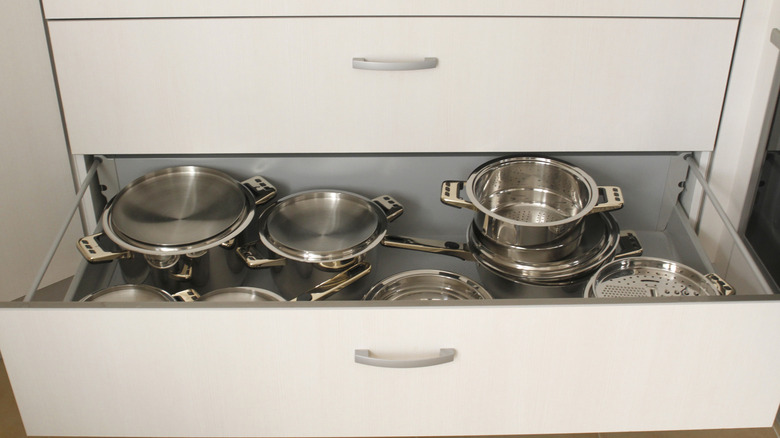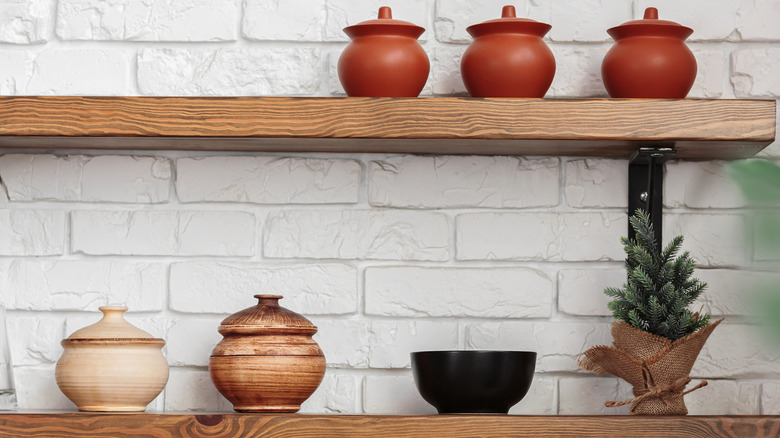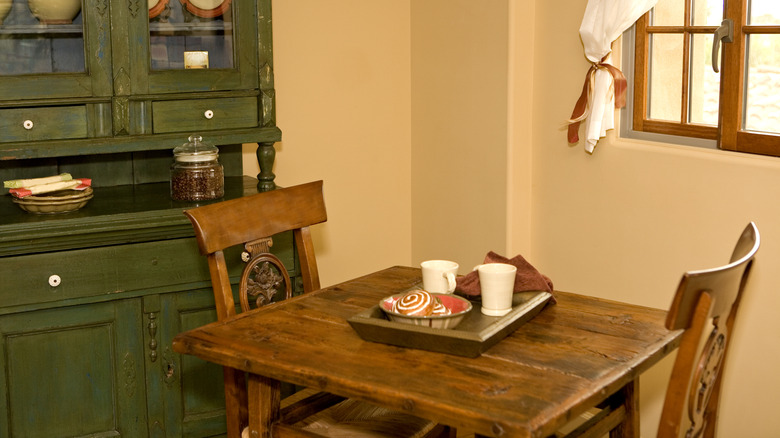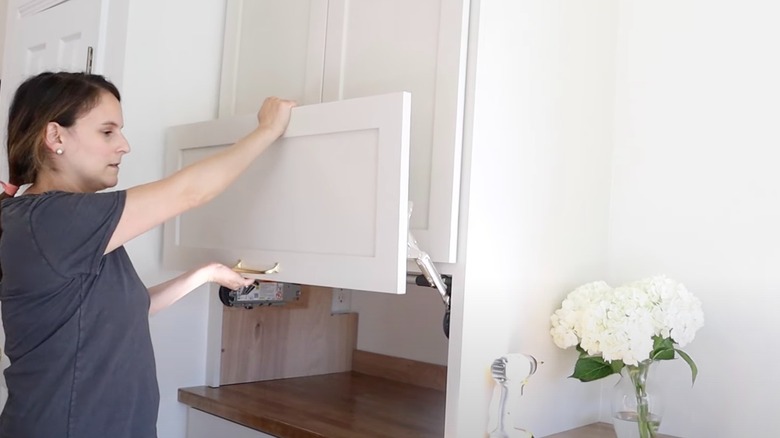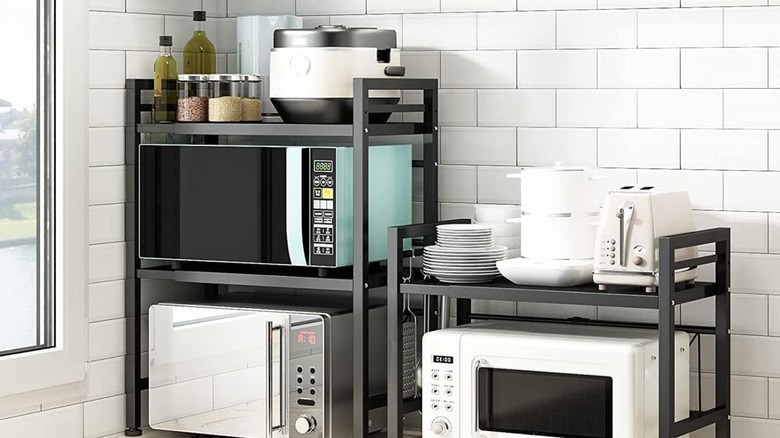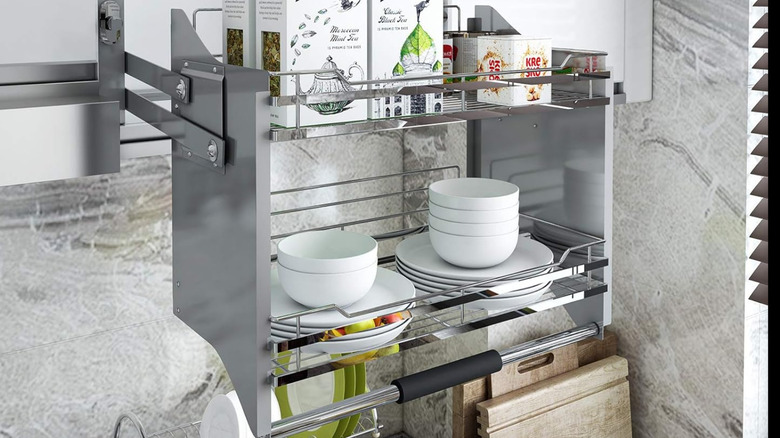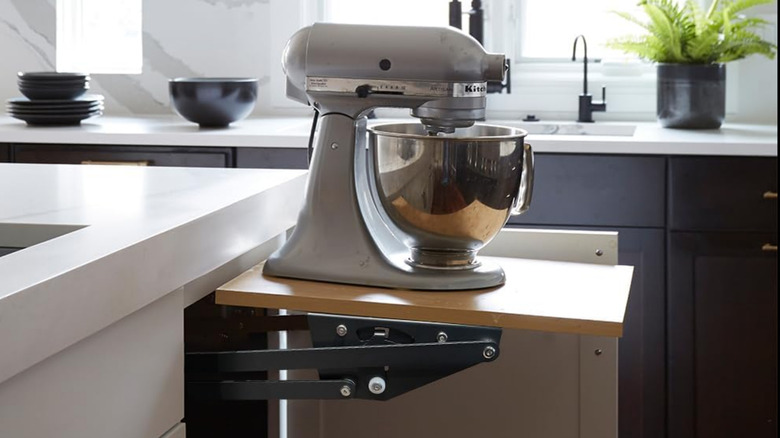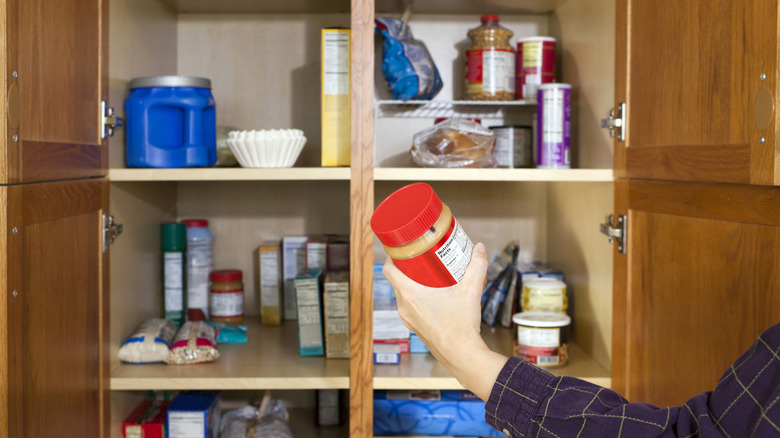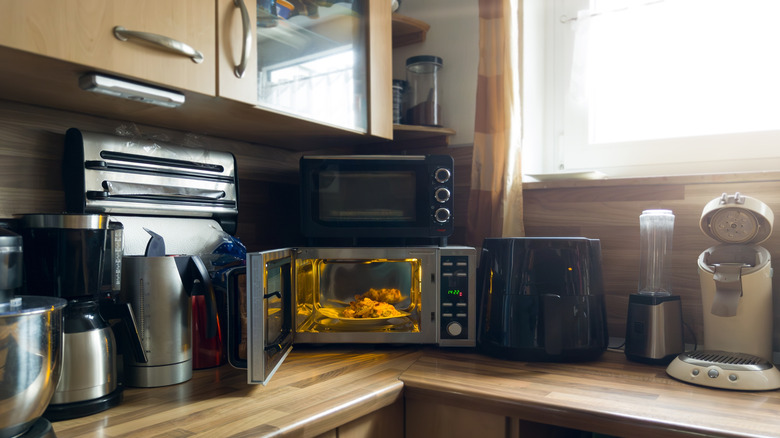13 Appliance Storage Ideas For Your Small Kitchen
If you're a fan of renovation shows on TV, you know what a designer's ideal kitchen looks like. It's often big and glossy with a large island, and above all, it has tons of storage space.
Unfortunately, that's not the world most of us live in. Storage is an issue even in regular-sized kitchens, and it's even worse for those of us who have small kitchens. It's not so bad for those cooks who rely heavily on packaged foods, or non-cooks who mostly order takeout, but for those who love to cook, space is a real constraint.
That's especially true when it comes to the small appliances that make cooking and baking so much more enjoyable. It's hard to invest in a great stand mixer, for example, when you're constantly asking yourself, "Where would I put that thing?" There are lots of creative ways to shoehorn a useful appliance or two into even the smallest kitchen, so we've rounded up a baker's dozen storage ideas for your consideration.
Use a rolling kitchen cart
One of the most useful ways to add some extra storage space to your kitchen is with a moveable kitchen cart. Most have a small work surface on the top, which you can dedicate to a specific regularly-used appliance, or leave free to give you some added prep space (a definite bonus!). Underneath, you'll find some form of shelving, cabinets, or baskets that can hold appliances of different sizes and types. When it's not in use, a small cart can be wheeled away to a convenient alcove, or maybe even stored in a closet.
Rolling kitchen carts are available in different sizes and price points to suit almost any kitchen and budget. Inexpensive moveable carts are pretty compact and relatively spartan, but offer great value for the dollar. A higher-end moveable kitchen cart (for those whose kitchens are not quite as small) is essentially a scaled-down kitchen island on wheels, which can be left in place or shifted around as necessary. Choose one that best fits your space and needs.
Put a pull-out corner shelf in your base cabinets
Not everybody loves a galley kitchen, but one of its greatest features is that you'll never have to deal with those awkward corner cabinets. Corner cabinets are collectively The Place Where Things Go To Die, and most of us have stories to tell about the things we've lost in them. They're basically the kitchen's version of the Bermuda Triangle.
But it doesn't have to be that way. Clever engineers at many manufacturers have created pull-out shelving to turn impractical corner cabinets into usable space, and many of them are heavy-duty enough to handle a surprisingly substantial appliance or two. Straightforward models simply have carefully-shaped shelves that rotate outward, and would work fine to store compact appliances like a food processor, hand mixer or immersion blender. Others have sturdy wire racks that slide in and out on rails for easy access, and are burly enough to handle heavier kitchen gadgets like a slow cooker or even a stand mixer.
You'll need to measure your bottom cabinets pretty carefully, so make sure you review the manufacturer's instructions before you make your purchase (and, as always, check the reviews). Sadly, this isn't an option that's available to most renters, though it never hurts to approach your landlord about putting one in. It'll appeal to future renters, after all.
Improvise a corner shelf in a currently under-utilized space
Some multi-unit homes or apartments are adapted from older buildings that have been divided up. This accounts for a lot of small kitchens, including the odd empty corners you find in many of them.
Those corners can become a convenient place to stash some of your appliances. The most bare-bones approach to utilize the space is to measure it, and then cut custom wooden corner shelves to fit there. It's straightforward enough to mount them, using wall anchors to attach a support before screwing in the shelves. Alternatively, you can buy floating corner shelves pre-made in a variety of finishes, and pick something that matches your existing cabinetry.
Floating shelves aren't your only option. You might, for example, find a freestanding corner shelf unit that can accommodate many of your smaller appliances. If your skills, budget, or sense of aesthetics calls for something higher-end, you might even have room in one of these small corners for a custom-made unit to match the rest of your cabinetry and hold several appliances.
Reallocate drawers for small appliances
You may not think of drawers as a place for appliances, but if your kitchen is well-furnished with drawers, you absolutely can fit appliances into them. You may have to find a different way to organize the cooking utensils that are already in them, of course, but that's not an incredibly taxing chore.
A shallow drawer can hold things like immersion blenders and small coffee or spice grinders, or a sous vide circulator. Drawers that are 4-6 inches deep can often hold a blender base and pitcher (on its side), or the base and work bowl of a food processor. Hand mixers and their attachments are another good choice for those medium-depth drawers, and so are clamshell-style waffle irons or contact grills (the George Foreman type).
Deep drawers meant for pots and pans are best of all, if you have them or can add them during a kitchen renovation. They'll be able to store items like a slow cooker, Instant Pot, large food processors, or even — depending on their depth — a deep stock pot.
Add vertical storage to your walls
Even many small kitchens contain a surprising expanse of bare wall. Adding storage to that vertical space is a great kitchen hack, and it can create space for appliances directly (by storing them on the shelves) or indirectly — transferring other kitchen items to the new storage space will free up other places to hold your appliances.
All kinds of vertical storage options can accommodate most kitchen layouts and workflows. Free-hanging cabinetry is a great option (if you can add it in a place where you won't bang your head on it regularly). Another alternative is open shelving or wire racks, the latter of which can be freestanding or mounted on the wall with heavy-duty anchors. Garage shelving is great for this — it holds a lot of weight, and you can hide it behind a curtain if the look is too "industrial" for your kitchen.
Other options to consider are wall-mounted baskets or a kitchen rail system, which can be used even in the tightest of kitchens to hold or hang utensils and gadgets. Relatively few appliances will fit a small basket or hang neatly from a rail, but (again) you can move other items into the new storage, and use the resulting free space for your appliances.
Make use of your nooks
Empty corners aren't the only hard-to-use spaces that can be turned into appliance storage. Many kitchens — especially in older houses or buildings repurposed into apartments — have odd, inconvenient spaces and weird little nooks. Those seemingly useless spaces can become a happy home for some of your appliances, like a stand mixer or coffee station — things you'd like to have close at hand without necessarily taking up part of your workspace (because prep space is also of premium value in small kitchens).
After installing your coffee counter or baking nook, you could even put in custom shelves to store additional appliances above that counter, further utilizing that empty space. Add custom doors to the cabinets if you want to conceal unsightly appliances. As always, choose lighter-weight appliances to go on the higher shelves, so you're less likely to injure yourself or drop and break the appliance while getting it down.
Add an appliance garage
If you're already planning a kitchen reno to upgrade your cabinets or pantry, you're in an enviable position. You'll have the opportunity to customize your space with your existing appliances in mind, and maybe even find room for one or two more that you really want.
We've already discussed a few options like corner units and deep drawers that you could add if you own your home, but doing a full rebuild of your cabinets gives you a clean slate. Arguably your best option, in that situation, is to organize your new cabinetry around an appliance garage. It's simply a countertop cabinet that's made for the exact purpose of holding your appliances, usually behind a garage-style closing door. Many of them also contain electrical outlets, so that several of your appliances can be used without ever leaving their home.
This is a pretty significant undertaking, so spend a lot of time on planning (and measuring!) before you commit. You could certainly hire a professional or, if you plan to DIY it, IKEA kitchen cabinets can help you get the job done on a budget.
Scrutinize your kitchen for space hogs
A few fortunate people are natural Marie Kondos or Martha Stewarts, with an innate eye for organization and efficient use of space. Most of us are not, so we muddle along through trial and error, or perhaps endure years of a "This is where I put it when I unpacked, so that's where it still is" organizational system.
If you fall in the second category, it's time to take a good, hard look at what's stored in your kitchen and where. Do you have cupboards or drawers filled with things that don't need to be in the kitchen? Can your microwave change location, thus freeing up a spot on your counter or in your cabinets? Could you find a more efficient storage solution for something bulky (like your pots and pans), and put appliances where those are currently?
If your kitchen contains a small island or peninsula, for example, you could suspend a rack from the ceiling over it (one of Martha Stewart's kitchen organization tips) and hang your pots there, freeing up their current space for your appliances. Wall storage can work for those, too. Julia Child's signature kitchen design tip — having a pegboard wall full of pots and pans — may be a step too far for you, but a rail or individual hooks on drywall anchors offer an efficient, low-cost place to store your pots or utensils, thus making space for appliances.
Freestanding metal racks can straddle your counter-dwellers
It feels terribly unfair that in small kitchens, where we desperately need all of the countertop space we can find for food prep purposes, we're also often forced to give up counter space to an appliance or two. It's hard to avoid plunking the microwave on a counter if there's simply no other practical place in the kitchen to put it.
If you absolutely have to give up counter space to an appliance, you can maximize that counter space by stacking other appliances over it. There isn't much you can do if upper cabinets lurk just a few inches above the microwave (or coffee maker, or toaster oven), but if you have open space, you should utilize it. Arguably the best way to do that is with a sturdy rack that's sized to straddle your existing appliance, providing shelves above it where other appliances can be stored or used.
You can find units online with one shelf, two shelves, or occasionally even three shelves to accommodate more appliances and other kitchen utensils. Many come with (or can accommodate) hooks or baskets along the sides for additional storage. There are plenty of options that can fit your budget and match the overall look of your kitchen.
Pull-down shelves are one of the best appliance storage ideas
Upper cabinets can be frustrating when you're storage-constrained, because they aren't the most versatile of places. Some have immovable shelves that won't hold larger appliances, for example. Others are just so awkwardly placed that they're inconvenient for storing anything you want to use regularly.
That's especially true for appliances. Keeping heavy appliances on high shelves is problematic (even when they do fit) because you run the risk of injuring yourself when you lift them down. Then there's the issue of smaller pieces, like the accessories for your food processor, the attachments for your stand mixer, or the multiple cups for your bullet-style blender. Those often get buried in the back of higher shelves, and then you'll need to get up on a chair or step-stool to fetch them down.
Pull-down shelves can transform your upper cabinets from frustrating to fantastic, especially if you can fully replace your cabinets' built-in shelves with them. They do exactly what their name would suggest: The shelf pulls out and down, giving you easy access to whatever you store there. The most common models can handle small appliances of up to 20 pounds or so per shelf, but if you shop around some manufacturers may offer larger, heavy-duty options as well.
An appliance lift is a great option
When it comes to small kitchens, there are both pros and cons of utilizing an appliance lift. It takes up some extra cabinet space, but it frees up counter space and will save you from expending the effort to lift a heavy appliance out of the cabinet.
The device itself is pretty straightforward. It consists of a pair of sturdy brackets that mount inside your lower cabinets, and arms with springs and gas cylinders will raise your appliance to counter level. A platform for your appliance to sit on is sometimes included with the unit, and sometimes purchased separately to match your counters or cabinetry. They're most often used for stand mixers, so you'll see them described as a "mixer lift," though they can be used for other appliances as well.
Most models assume that you'll have the full height of your base cabinets to work with, and they don't work as well if you have a drawer to account for. This isn't necessarily an issue — just look specifically for one that will raise the appliance a few extra inches to compensate.
Carve out space in your pantry
If you have a pantry in or just outside your kitchen, it could potentially be a good place for appliance storage. Pantries have varying combinations of shelving, drawers, and pull-out sliders, and you can be pretty creative about using those for appliances.
Take a long, hard look at your pantry unit, and ask yourself where appliances might reasonably fit. If the pantry is outside your kitchen, think primarily in terms of lesser-used appliances; this is not the place for the toaster oven or coffee maker you use all day. You might move an adjustable shelf to make space for a tall stand mixer, or use a heavy duty pull-out drawer for a hefty slow cooker.
Carving out pantry space for appliances is always a compromise, because it means you'll have less space for food storage. Pantry items are often things that can be packed up together, though, so grouping them into storage containers (long storage containers, if you have deep pantry shelves) can make your food storage more efficient and compensate for the lost space.
Stack your appliances
This may look like a desperation move at first glance, but it's surprisingly practical in incredibly tight kitchens. It's essentially the "buy a rack to straddle your microwave" option, but without dishing out the money for the actual rack.
Here's the thing: If there's one appliance you give up counter space for, it's probably a microwave. And microwaves already have a big, flat, sturdy surface on top. Usually those collect dust — and they sometimes hold something mildly useful like a paper towel holder or a box of tissues — but why shouldn't they also attract appliances?
As long as you aren't blocking the microwave's vents (and there's room above it) that's a place you could put a toaster or toaster oven, a folding contact grill, a blender or food processor, or maybe even a portable induction cooktop. The same outlet that services the microwave works for your second appliance, and you're not giving up any additional counter space. It's a pretty good kitchen countertop hack.

